Imagine a place that has been around for centuries and has a mixture of two totally different architectural styles. This is Mariánská Týnice in the Czech Republic!
Mariánská Týnice is located in the Plzeň region in the west of the Czech Republic, about 35 km northeast of Pilsen.

Foundation and early history
The history of Mariánská Týnice dates back to the Middle Ages. Originally, a Gothic church dedicated to the Virgin Mary stood in this place. Over time, this place became an important place of pilgrimage, where many believers came to express their devotion to the Virgin Mary.
A special builder
The present appearance of Mariánská Týnice is strongly influenced by the Baroque period. This is where Jan Blažej Santini-Aichel comes in, a super talented master builder! He mixed the old Gothic church style with the new Baroque style. The so-called Baroque Gothic style was created in Bohemia.

By order of Abbot Evžen Tyttl of Kladruby, Santini was commissioned to build a new pilgrimage church and an adjoining monastery. A cloister was added to the original medieval building. In 1699 a provostry was built here. The church of the Annunciation of the Virgin Mary was built. Santini’s characteristic signature can be found throughout this complex: curved lines, intricate facade details and innovative structural elements.
After the Baroque and until today
The entire building project was never completed. Due to financial problems of the monastery in the late 18th century and its closure by Joseph II in 1785, the construction work came to a halt. In the 19th century, after the Metternich family acquired the property in 1826, it began to gradually decay. When the family used it for economic purposes, the condition of the building deteriorated further. The final blow was the collapse of the church dome between 1919 and 1920.

Later, an association was formed called “Unity for the Salvation of Mariánská Týnice”. This group started the gradual restoration.

In the 1950s, a museum was established on site. After 1990, state institutions and local authorities intensified restoration efforts. The facade of the provost’s building was completely restored, two new onion domes with clocks and bells were erected, and the courtyard was renovated. In 2000, the dome was completed and put back on.

Although the place no longer functions in its original religious capacity, Mariánská Týnice remains an important cultural and historical site in the Czech Republic. This attracts both locals and tourists who appreciate its architectural beauty and historical significance.

The museum
Who steps through the entrance of the convent is first in a museum. On the first floor we could see an exhibition about the complex and Santini, on the upper floor there are permanent exhibitions in addition to the temporary exhibition.
Exhibition about the plant and Santini
Jan Blažej Santini-Aichel was an important architect of the Baroque and the so-called Baroque Gothic style. The exhibition presents his biographical data and explains his special approach to architecture, which influenced Mariánská Týnice and many other buildings in the Czech Republic.
The exhibition highlights the history of the monastery and the church from its beginnings to the present day. Visitors can learn more about the specific architectural features and details of the complex

I liked very much that especially this area of the exhibition works with many pictures, but also with models and drawings, so I not only learned a lot, but also had the visual connection right away.
The museum on the second floor focuses primarily on regional history. There are recreated rooms that show, for example, a kitchen or a restaurant. I was able to admire various traditional costumes and also look at ecclesiastical objects.


Church
As I step through the entrance of the church from the museum, I find myself behind the altar. It is an unusual and fascinating aspect of the church that one must first walk around the altar to enter the interior.

The altar itself is rather plain. But instead, I immediately notice the impressive wall design behind the altar. To me, the drawing almost seems as if it forms an extension of the altar.
The ground plan of the church resembles a cross with arms of equal length. A dome rises in the middle. Almost infinitely one looks into the height and I have trouble to recognize the design of the dome more exactly. Fortunately, there is the zoom of the camera, which can show me the beautiful painting more precisely.


Otherwise, I feel the church is quite “empty”. There are no pews, no choir stalls, no columns, hardly any wall design. The windows of the church are colorless and let the daylight stream in unhindered.
The courtyards and cloisters
Through a door in the back we leave the church and enter the first courtyard with the surrounding cloister. A small fountain gurgles, flowers bloom and carefully trimmed hedges structure the courtyard. From here I have a good view of the two church towers.

In each case, the “corners” of the cloister are designed with drawings that are worth looking at. I like them very much.
The small courtyard is wonderfully quiet and I would have loved to sit here on a bench and enjoy.
There is a second courtyard with a surrounding cloister. We reach it through a second door in the church. The structure is quite similar to the first cloister. Here, however, there is a mural that one should definitely take a closer look at. The people depicted there look quite different from those in the other paintings. Here the artist has placed real people in a biblical scene. These are people who were involved in the construction and thus remain in memory. I like the idea and if it had not been pointed out to me specifically, I would not have noticed!

Is it worth the visit?
Definitely! Anyone interested in the history of architecture and especially Santini will find an outstanding example of his work in Mariánská Týnice. Through the exhibition, I think, many things became clear to me that I otherwise would not have noticed and I understood his architectural style much better.
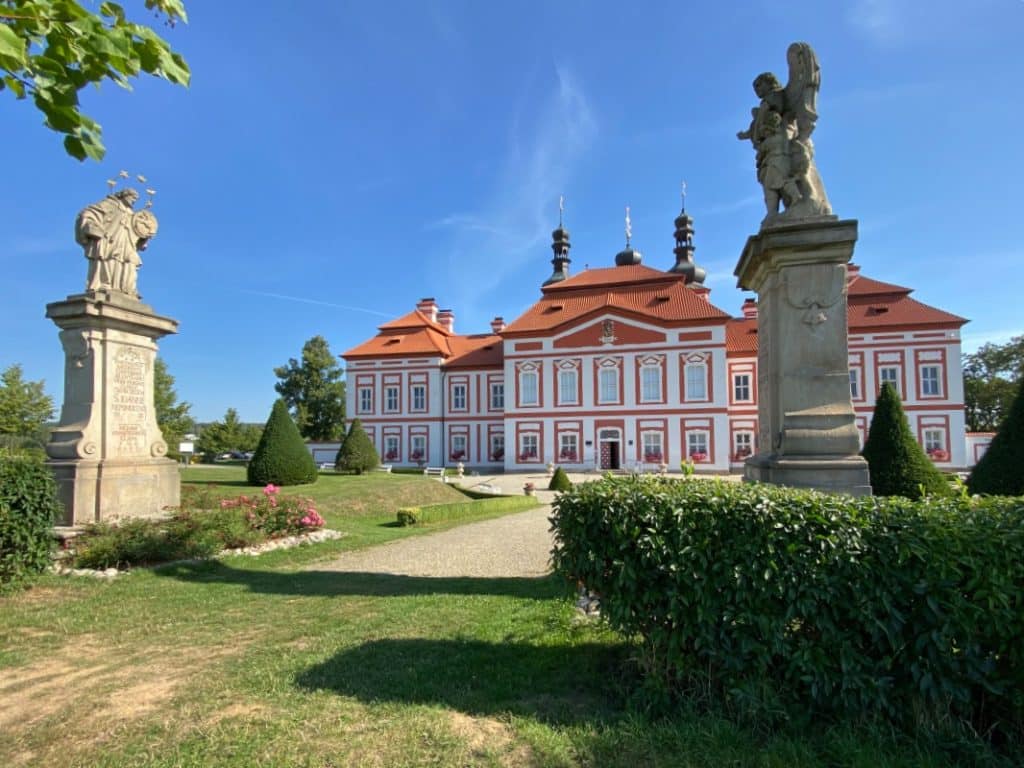
Address:
Mariánská Týnice 1
331 41 Kralovice
Opening hours:
May – August
Tuesday – Sunday: 9-18 h
April, September and October
Tuesday – Sunday: 9-17 h
November – March
Monday – Friday (only on working days): 9-15 a.m.
Entrance fees:
Variant 1:
Church of the Annunciation, the western and eastern cloisters, the exhibition Baroque and its World, the exhibition Century of Renovation.
Adults: 80,- CZK
Variant 2:
Museum, current exhibitions, the refectory
Adults: 120,- CZK
During the wedding ceremonies the church and the cloister are closed to the public.
The visit to Mariánská Týnice was an item on the program of a press trip to Pilsen.




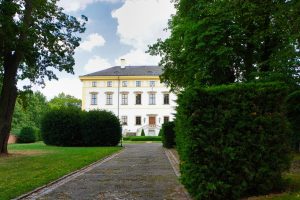






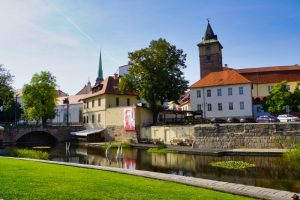









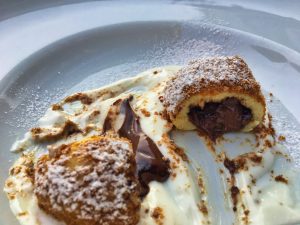


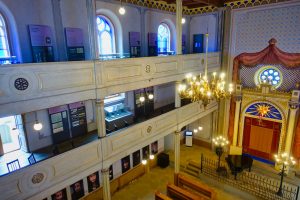

Leave a Reply